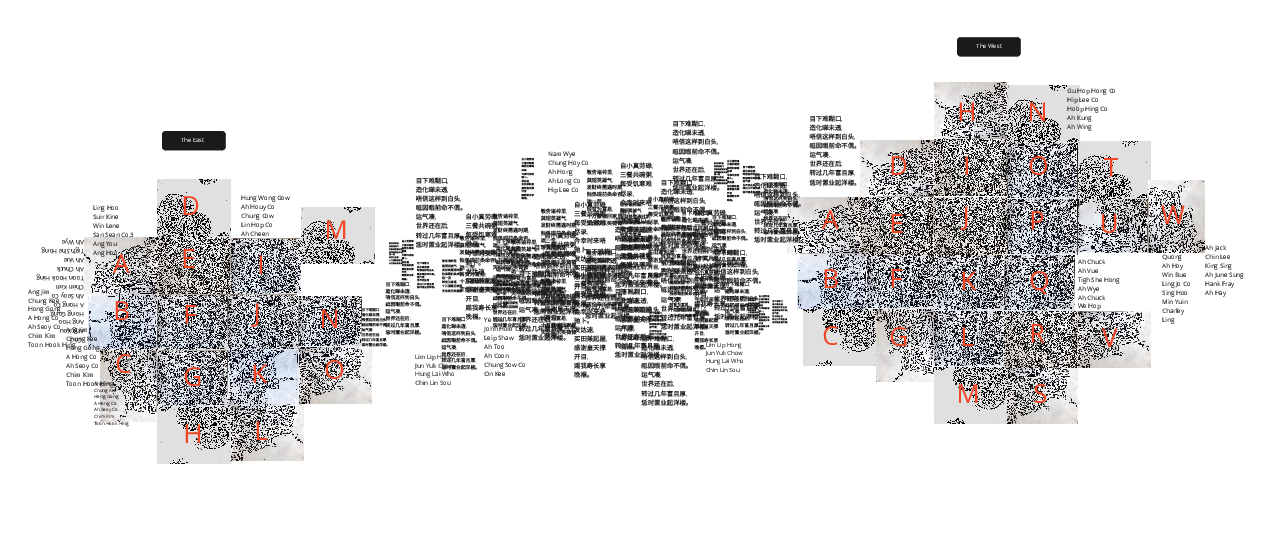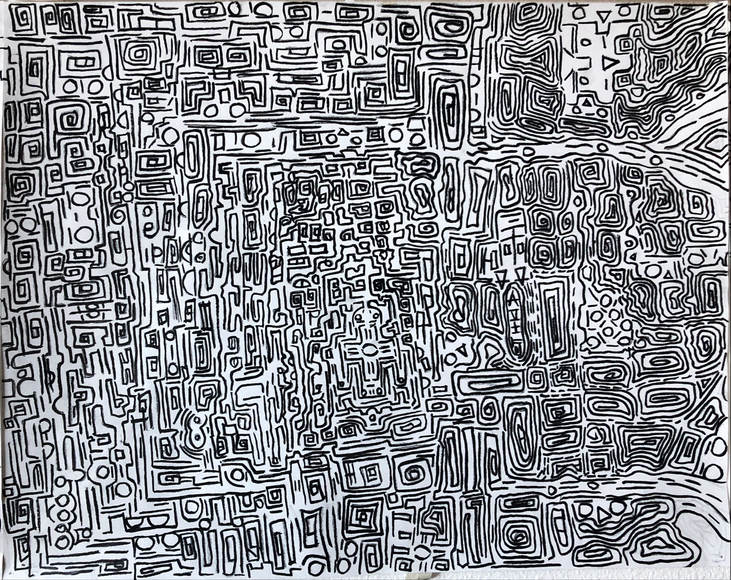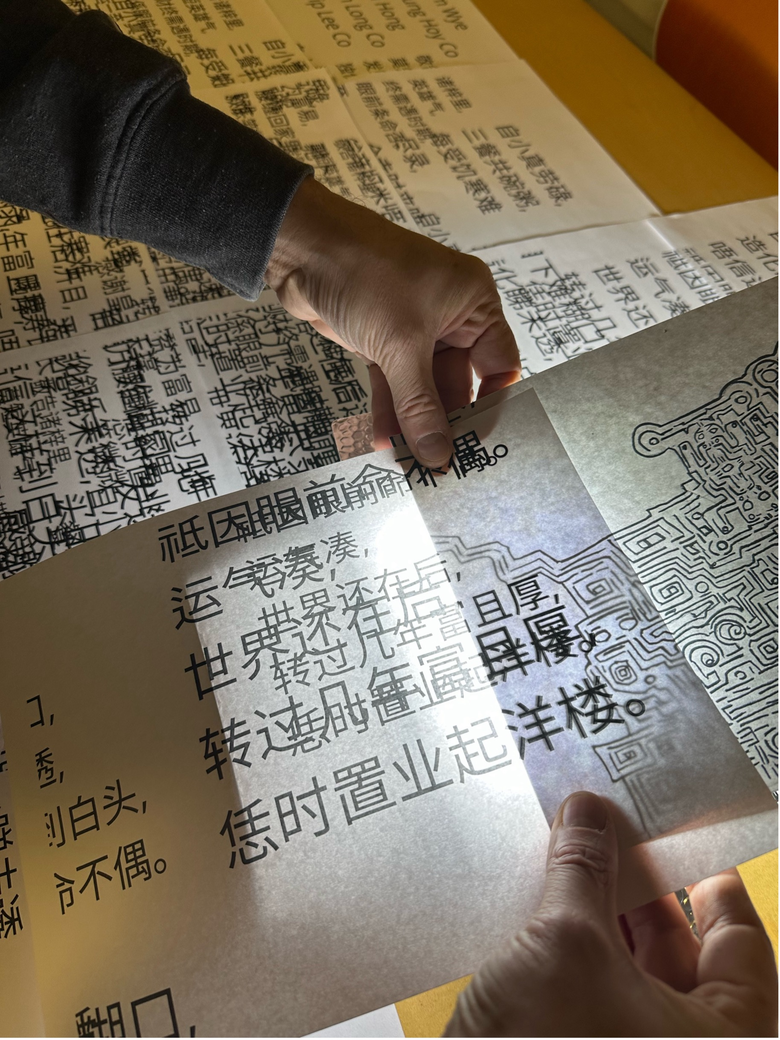Time loops in cycles, revealing the ways in which trauma from the past continues to trouble the present, casting a shadow over possible futures.
–– Leeb-du Toit, Simbao, & Anthony, 2022
Visually, The East & The West represents a ‘hyphenated condition’ (Ling 1980), which is an experience where individuals feel they are balancing on an edge, slipping from one side of the hyphen to the other. This reflects the struggle of many immigrants who belong to multiple cultures without feeling entirely at home in either side (Leeb-du Toit et al. 2022: 33). Their homes and themselves are caught between two worlds -- the east and the west/China and America/childhood home and current home. In this piece, the landmasses consists of my ghostly patterns, a symbol of disorientation. Between these two places, the middle section of the work, represents the Pacific Ocean, where ‘tens of thousands of letters traveled back and forth across the Pacific in the mid-to-late nineteenth century’ (Chang 2019: 9). The blurred effect of the overlayed texts -- poetries, songs, and ‘names’ ––represents how we are gradually losing the history and forgetting the Chinese railroad workers.
No texts in Chinese or English, which were written by Chinese railroad workers on the U.S. Transcontinental Railroad have been identified, either in the United States, China, or anywhere else. Such absence of historical records can be attributed to various forms of destruction, including arson, looting, deliberate targeting of Chinese belongings by hostile mobs during the nineteenth century, natural disasters like earthquakes and fires in San Francisco, and forced relocation of immigrants (Chang 2019: 9). During the 1870s, the remains of thousands of Chinese migrant workers were transported across the Pacific Ocean back to China (Chang 2019: 37). To represent the remains of these migrant workers, I used the Anglicized Chinese immigrant ‘names’ on C.P.R.R. payroll records. Furthermore, through remixing my maze patterns with relevant Chinese poems, ballads, and songs from qiaoxiang (Cangdong) documents, ‘The East & the West’ aims to bring texture to the lost history of Chinese railroad workers on the U.S. Transcontinental Railroad.
The East & The West is the project’s signature piece, and it was physically installed as a mural measuring 2x5 meters in the Georgetown University Car Barn. Rather than using beautiful city maps that represent space but exclude those who contributed to building it, I used ceramic sherd patterns to tell the lost history and story of these Chinese railroad workers. In my work, ‘The East & the West,’ the hand-drawn ghostly pixel patterns strongly echo the molded key fret banded decoration pattern (CVAP IN-00408.001) from a storage vessel, recovered at Qiaoxiang (Cangdong Village), the ancestral home of many Chinese railroad workers (Voss et al. 2019: 35; Figure 3). The U.S. Transcontinental Railroad was handmade — constructed by relentless, repetitive labor under harsh conditions, much of it carried out by Chinese migrant workers whose perseverance and sacrifice shaped its path. My ghostly pixel patterns re-present this repetition, infinity, patience, and the passage of time, echoing the spirits of those whose hands laid the steel tracks that connected America.
First, I digitalized my six hand-drawn ghostly patterns, which are past works I completed in 2022 and 2023. The materials include traditional Chinese ink, Strathmore sketch paper (9’’x12’’), thin brushes, Winsor & Newton Ink, Pentel Brush Pen, and so on. I then uploaded these six patterns to the Miro Board, copied, pasted, and reworked them to create a larger pattern. As stated, the ‘names’ on the edges of the work, as well as the overlaid text of ‘names’ and Chinese poetry in the central ocean section are taken from CPPR payroll records and qiaoxiang documents from Cangdong village. The difficult to read texts in the center represent the letters and the bodies of migrant works that were transported across the Pacific in great numbers but remain lost.
To physically install the piece, we cut, trimmed, and printed all the texts, and we wished to overlay. We measured each text piece to calculate the entire installation size and determine that the final dimensions in centimeters (Figure 10). We then printed the text at 1021 percent of the image size to align the image output of the MiroBoard with the pixel count of the originally scanned ghostly pixel images. Although we had digital photos of each ghost pixel pattern, we broke the pattern into multiple smaller PDFs, each of which had was then re-sized. If we encountered any misalignment during the physical installation, we double checked our measurements and reprinted what was necessary. Then, we overlaid the texts on an LED light board to ensure proper alignment of text and that the overlays matched correctly (Figure 11). This was especially important in the center text of 'The West and The East', where precise lapping was required. The artistic process of aligning multiple material artifacts in order to create a larger network resonated with the careful, precise and repetitive work of the Chinese migrants who aligned and connected the metal tracks of the transcontinental railroad.
While conducting labor on the railroad, Chinese workers were typically documented in terms of ‘labor-time’ and ‘work units’ (Khor 2106: 447). In other words, the CPRR payroll records bear this ‘capitalist logic of labor abstraction’ (Khor 2016: 444), in which human workers become units of economic value. In a similar process, during the physical installation of the East and The West, we utilized used Miro and Microsoft Excel spreadsheets to calculate the length, width, and proportions of individual ink-drawn patterns as well as the total number of each pattern categories. This abstracted artistic expressions of human creativity and labor (Figures 4-9) as mere units of construction (Figure 12). Later, for efficiency, we used the letters ‘E’ and ‘W’ to represent ‘East’ and ‘West.’ We labelled each of the ghostly pixel patterns as ’E-A,’ ‘E-B,’ ‘E-C,’ ‘W-A,’ ‘W-B,’ ‘W-C,’ etc. (Figure 13).
This installation process reflects the way in which capitalism reduces human labor to measurable units, thereby mirroring how the names of invisible Chinese railroad workers were removed from U.S. History. Each of the six ghostly pixel patterns took nearly nine hours to draw by hand. Simply assigning letters like ‘A,’ ‘B,’ ‘C,’ ‘D,’ etc. to digital copies of these drawings reduced hours of human labor to abstract dehumanized symbols. This parallels how Chinese workers’ names were erased and altered by the Central Pacific supervisors, how the presence of Chinese workers was muted in photographs, and how the individual lives, with families and dreams, were reduced to labor-time and economic value. During the physical installation of The East and the West, I experienced this sudden realization, which made me acutely aware of how industrial capitalism alienated and abstracted the labor effort of the Chinese railroad workers. The realization brought me much closer to these invisible Chinese workers, whose struggles on harsh terrain and inclement weather must have felt even more disheartening than our installation mistakes and mismeasurements, which occurred in climate-controlled university building.
< Previous
Figure 4: Ghostly Pixel Pattern #1.
Haoqing Yu, Autumn 2021.
Hand-made drawing, Traditional Chinese Ink, Strathmore Sketch Paper, 9’’x12’’.
Figure 6: Ghostly Pixel Pattern #3.
Haoqing Yu, Winter 2022.
Hand-made drawing, Traditiona Chinese Ink, Strathmore Sketch Paper, 9’’x12’’.
Figure 8: Ghostly Pixel Pattern #5.
Haoqing Yu, Winter 2023.
Hand-made drawing, Traditional Chinese Ink, Strathmore Sketch Paper, 9’’x12’’.
Rail after rail was laid across the field in machinelike fashion, the same operation repeated ad infinitum.
…Supply trains came along regularly to provision and feed the workers. Time was of the essence.
–– Chang, 2019
Figure 2: The East and The West. Haoqing Yu, 2024. Mixed-media art, traditional Chinese black ink, Pentel color brush pen, Miro Board, ink patterns, six pieces of Strathmore sketch paper (9’’x12’’).
Figure 3: Chinese brown-glazed stoneware vessel. Ceramic sherd showing neck of vessel, with an elaborate molded key fret banded decoration at the rim (Voss et al., 2019: 35, CVAP IN-00408.001). The hand-drawn ghostly pixel patterns (Figures 4-9) strongly echo the pattern of this stoneware.
Figure 5: Ghostly Pixel Pattern #2.
Haoqing Yu, Winter 2022.
Hand-made. drawing, Traditiona Chinese Ink, Strathmore Sketch Paper, 9’’x12’’ .
Figure 7: Ghostly Pixel Pattern #4.
Haoqing Yu, Winter 2022.
Hand-made drawing, Traditional Chinese Ink, Strathmore Sketch Paper, 9’’x12’’.
Figure 9: Ghostly Pixel Pattern #6.
Haoqing Yu, Winter 2022.
Hand-made drawing, Traditional Chinese Ink, Strathmore Sketch Paper, 9’’x12’’.
Next >











